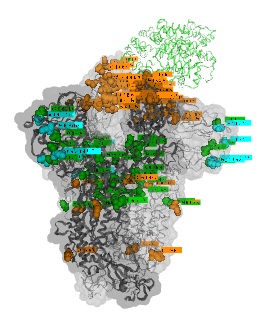|
Specific RT-qPCR assays enable rapid identification of newly emerging SARS-COV-2 variants such as the Omicron (B.1.1.529) virus variant of concern. The assays target characteristic mutations in the nsp6 (Orf1a), spike, and nucleocapsid genes. Also, multiplexing PCR may be a reliable assay to identify B.1.1.529 in suspected samples.
The Omicron variant (SARS-CoV-2 B.1.1.529) in November 2011 emerged in South Africa and Botswana. Travel-related cases were already identified in Hong Kong, Belgium, and Israel at the end of November. As of 01-11-2022 Omicron has now been discovered in all seven continents. However, since Omicron variants with and without deletions in the spike protein and others are co-circulating, the correct diagnose using PCR tests is complicated.
GISAID is tracking Omicron and other variants of SARS-CoV-2 and reported 271,805 Omicron genome sequences on 01-11-2022.
|

GISAID
|
Specific RT-qPCR assays enable rapid identification of newly emerging SARS-COV-2 variants such as the Omicron (B.1.1.529) virus variant of concern. The assays target characteristic mutations in the nsp6 (Orf1a), spike, and nucleocapsid genes. Also, multiplexing PCR may be a reliable assay to identify B.1.1.529 in suspected samples.
A list of mutations for a variety of variants can be reviewed at here!
The Omicron variant (SARS-CoV-2 B.1.1.529) first emerged in November 2011 in South Africa and Botswana.
Travel-related cases were already identified in Hong Kong, Belgium, and Israel at the end of November.
As of 01-11-2022, Omicron has now been discovered in all seven continents. However, since Omicron variants with and without deletions in the spike protein and others are co-circulating, the correct diagnose using PCR tests is quite complicated.
GISAID is tracking Omicron and other variants of SARS-CoV-2 and reported 271,805 Omicron genome sequences on 01-11-2022. Oran et al. recently reported four RT-qPCR assays that allow the rapid identification of the newly emerging SARS-CoV-2 Omicron variant of concern. With its 30 mutations in the spike protein alone, this variant of concern (VOC) can potentially increase transmissibility and reduce vaccine effectiveness. Therefore, assays that allow the specific detection of this variant are needed. RT-qPCR assays can be implemented and performed in any molecular diagnostic laboratory without requiring specific brand instruments or unique reagents.
Primer and Probes for Specific Detection of the Omicron Virus
|
Name
|
Label 5’
|
Oligonucleotide Sequence (5’>3’)
|
Label 3’
|
Working Conc. [μM]
|
Reference
|
| |
|
N Protein
|
|
|
|
|
Ndel positive detection
|
|
|
|
|
|
|
28322 Fwd
|
None
|
TTTGGTGGACCCTCAGATTC
|
None
|
20 - 50
|
Oran et al. 2021
|
|
28424 Rev
|
None
|
CGCAGTATTATTGGGTAAACCTTG
|
None
|
20 - 50
|
“
|
|
28354 probe
|
FAM
|
CCAGAATGGTGCGGCGCGATC
OM185476.1 28279 to 28299; Etc.
|
BHQ1
|
5 - 10
|
“
|
|
Ndel negative detection
|
|
|
|
|
|
|
2019-nCoV_N1-F1a
|
None
|
CTAAACGAACAAACTAAAATGTCTG
|
None
|
20 - 50
|
Oran et al. 2021
|
|
2019-nCoV_N1-R1a
|
None
|
GCCCCACTGCGTTCTCCATTC
|
None
|
20 -50
|
US CDC
|
|
2019-nCoV_N1-P
|
FAM
|
ACCCCGCATTACGTTTGGTGGACC
LC666943.1 28293 to 28316; etc.
|
BHQ1
|
5 - 10
|
Oran et al. 2021
|
|
Sindel reaction
|
|
|
|
|
|
|
22174 Fwd
|
None
|
GTTATTTTAAAATATATTCTAAGCACACG
|
None
|
20 – 50
|
“
|
|
22248 Rev
|
None
|
TAAAGCCGAAAAACCCTGAG
|
None
|
20 - 50
|
“
|
|
22206 probe
|
FAM
|
ATTATAGTGCGTGAGCCAGAAGATCTCC
OM185480.1 22109 to 22136; etc.
|
BHQ1
|
5 - 10
|
“
|
|
Nsp6 deletion reaction
|
|
|
|
|
|
|
11248 B529 Fwd
|
None
|
ATATGGTTGATACTAGTTTTAAGC
|
None
|
20 -50
|
“
|
|
COV19_11344_R
|
None
|
ACACAGTTCTTGCTGTCATAAGG
|
None
|
20 -50
|
“
|
|
COV19_11310_P
|
FAM
|
CTGTGTTATGTATGCATCAGCTGTAGT
LC666933.1 11292 to 11318; etc.
|
BHQ1
|
5 – 10
|
|
|
E-sarbeco reaction
|
|
|
|
|
|
|
E_Sarbeco_F1b
|
None
|
GTTAATAGCGTACTTCTTTTTCTTGC
|
None
|
20 -50
|
Corman et al.
|
|
E_Sarbeco_R2
|
None
|
ATATTGCAGCAGTACGCACACA
|
None
|
20 – 50
|
“
|
|
E_Sarbeco_P1
|
TXRed
|
ACACTAGCCATCCTTACTGCGCTTCG
LC666943.1 26323 to 26348; etc.
|
BHQ2
|
5 - 10
|
“
|
Note: TaqMan® or FRET probes are usually labeled at the 5′-end with the reporter molecule 6-carboxyfluorescein (FAM) and with the quencher, Black Hole Quencher 1 (BHQ-1) at the 3′-end. Alternatively, probes can also be labeled at the 5′-end with the reporter molecule 6- carboxyfluorescein (FAM) and with a double quencher ZEN™ Internal Quencher positioned between the ninth (9th) and tenth (10th) nucleotide base in the oligonucleotide sequence and Iowa Black® FQ (3IABkFQ) located at the 3’-end.
In addition, a ROX probe reaction mixture may be used as well.
Reference
Corman VM, Landt O, Kaiser M, Molenkamp R, Meijer A, Chu DK, Bleicker T, Brünink S, Schneider J, Schmidt ML, Mulders DG, Haagmans BL, van der Veer B, van den Brink S, Wijsman L, Goderski G, Romette JL, Ellis J, Zambon M, Peiris M, Goossens H, Reusken C, Koopmans MP, Drosten C. 2020. Detection of 2019 novel coronavirus (2019-nCoV) by real-time RT-PCR. Euro Surveill 25:2000045. [PMC]
Oran Erster, Adi Beth-Din, Hadar Asraf, Virginia Levy, Areej Kabat, Batya Mannasse, Roberto Azar, Ohad Shifman, Shirley Lazar, Michal Mandelboim, Shay Fleishon, Ella Mendelson, Neta S Zuckerman; SPECIFIC DETECTION OF SARS-COV-2 B.1.1.529 (OMICRON) VARIANT BY FOUR RT-qPCR DIFFERENTIAL ASSAYS; medRxiv 2021.12.07.21267293; [ medrxiv ]
US CDC Omicron Update
CDC COVID-19: SARS-CoV-2 Variant Classifications and Definitions
---...---
Bio-Synthesis provides a full spectrum of high quality custom oligonucleotide modification services including back-bone modifications, conjugation to fatty acids and lipids, cholesterol, tocopherol, peptides as well as biotinylation by direct solid-phase chemical synthesis or enzyme-assisted approaches to obtain artificially modified oligonucleotides, such as BNA antisense oligonucleotides, mRNAs or siRNAs, containing a natural or modified backbone, as well as base, sugar and internucleotide linkages.
Bio-Synthesis also provides biotinylated mRNA and long circular oligonucleotides.
---...---